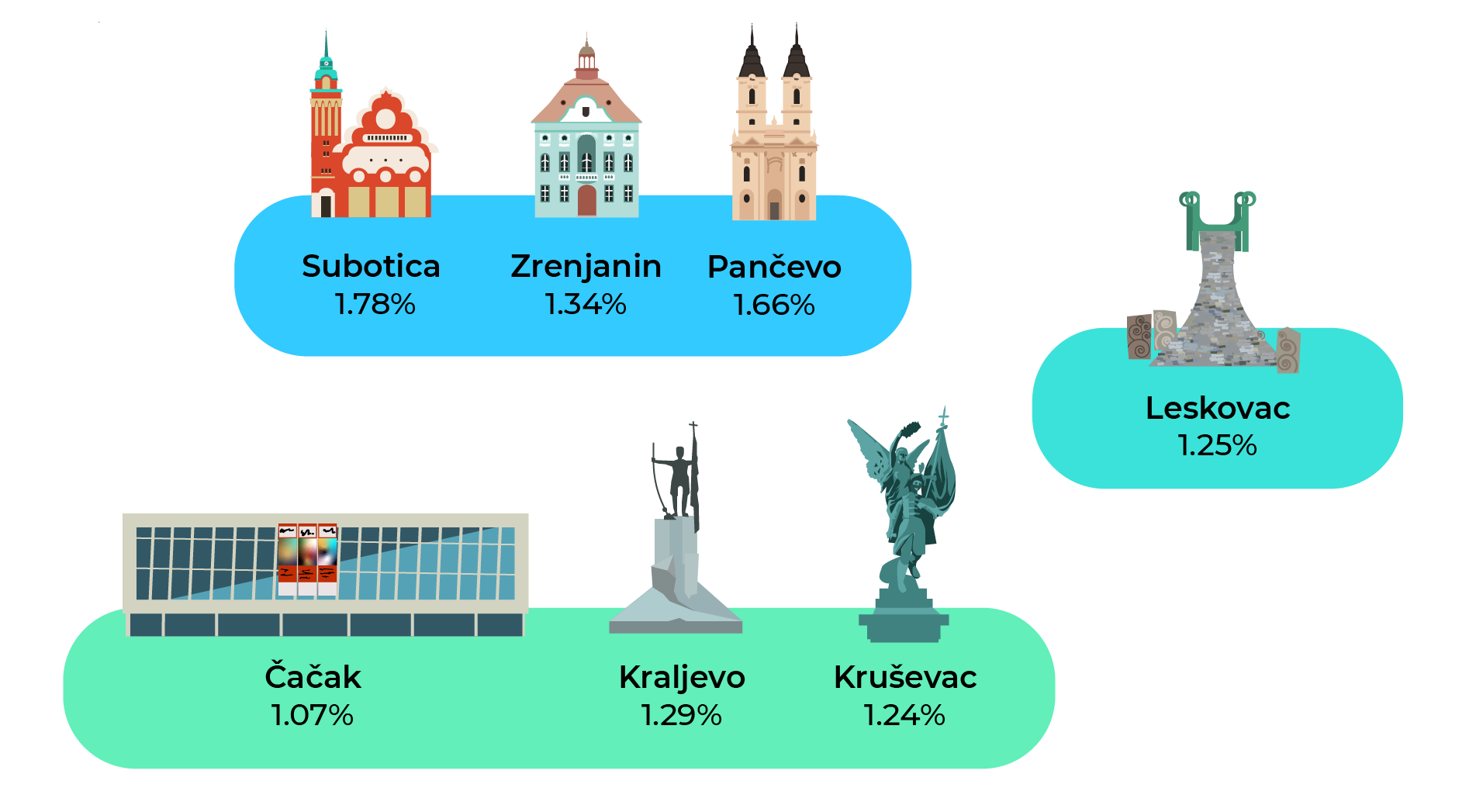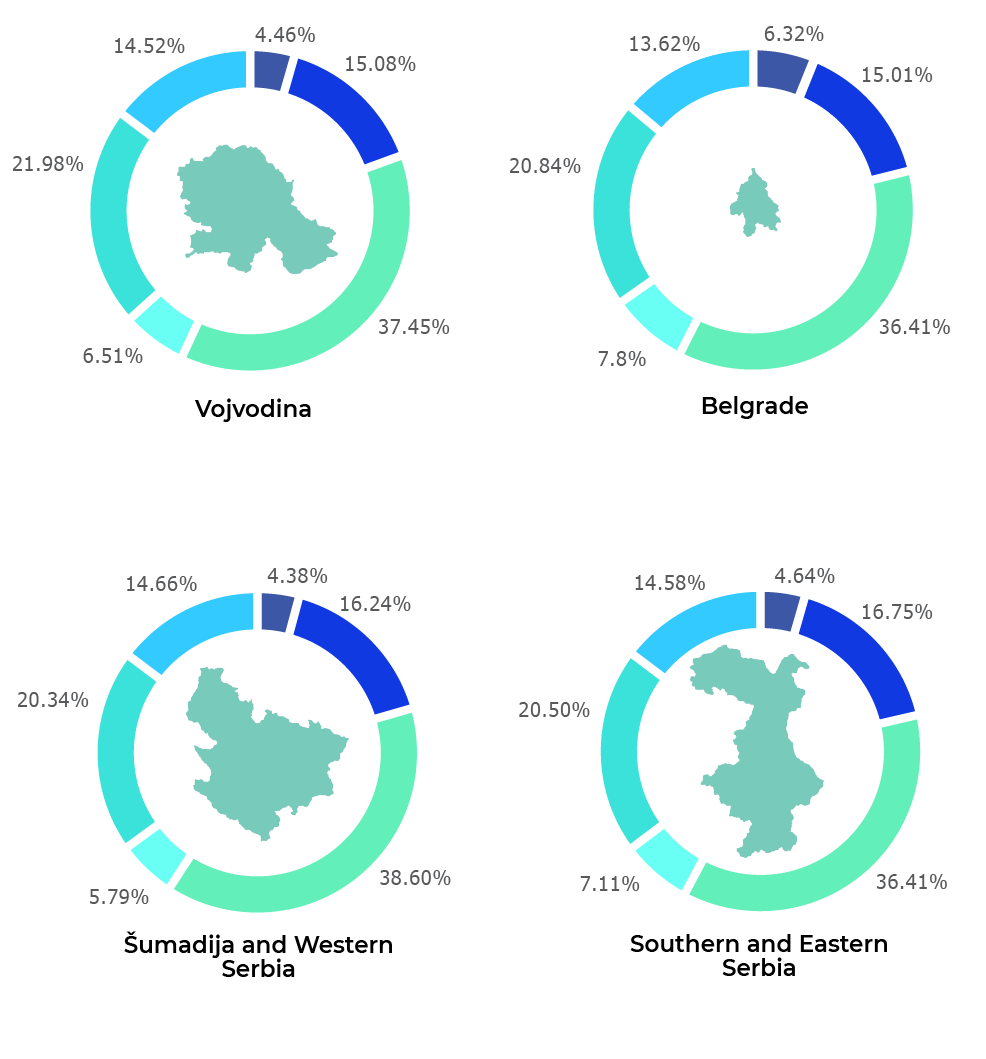GIGMETAR REPORT OCTOBER 2022
Gigmetar’s latest measurement covered a population of 11,596 gig workers, an increase of 14.5 percent. As the previous survey had registered similar growth (at 15.9 percent), the freelancer workforce increased overall by one-third over the past year.
HIGHLIGHTS

Growth of freelancers from Serbia has continued on the most popular gig work platform – 14.5 percent, relative to the previous measurement

The latest survey has identified a shift in growth away from large urban centres to smaller settlements

Šumadija and Western Serbia recorded the highest rate ofgrowth, with these regions’ gig workforces increasing by close to one-third

Užice topped the growth charts after its freelancer population more than doubled

Writing and translation has seen the greatest increase (over 24 percent), with the smallest yet still significant growth (at 7.5 percent) registered in sales and marketing support

Men entering the gig workforce outnumbered women across all occupations, with the changes at their most visible in writing and translation (where the men to women ratio was 16 to 1)

Freelancers’ median hourly rates have rocketed to $18

The income gap has reached a historic low, with women commanding on average 85.6 percent of men’s hourly rates
RESULTS IN DETAILS
Two factors may have helped drive this growth: either the increasing popularity of gig work in the Serbian market, which would be consistent with the findings of Payoneer’s latest Global Freelancer Income Report, or a redistribution of gig work between platforms due to increasingly fierce competition. Other causes have also prompted an increase in the freelancer workforce and made it more attractive. These have included fast-paced technological development, which has made gig work more accessible globally; disruptive changes to companies’ business models that have forced them to keep seeking talent and human resources outside their own organisations to achieve growth, respond to competitive pressure, and engage in technology-driven transformation; and demographic changes and evolving preferences of new entrants to the workforce, who view freelancing as an attractive alternative for career-building. Lastly, incomes have increased due to the rising exchange rate of the dollar, the exchange currency in the gig work sector, with the US currency now worth 20 percent more against the Serbian dinar than a year ago. These trends have remained unchanged, notwithstanding the uncertainties surrounding the global economic recovery as the pandemic abates and the crisis caused by the war in Ukraine.
According to the latest measurement, 20.2 percent, or one-fifth, of all Serbian freelancers were working on a particular project at the time of the survey. This was on average 2.9 percentage points (pp) less than in the previous two rounds of measurement. The reasons behind this apparent contraction can be sought in fairly high levels of competition worldwide, with the supply of gig work potentially outstripping demand for it, the relatively high cost in terms of time invested in seeking work, and the burden of competing for work globally as opposed to looking for jobs in the conventional labour market.
The latest survey suggests women were again likelier than men to have work at the time of the measurement. Here, 36.8 percent of the freelancers engaged at the time of the survey were women, a percentage greater than their share in the overall gig workforce (of 32.8 percent). The most recent measurement also found a reduced percentage of continuously employed workers, meaning those who had work at the time of both the latest survey and the one preceding it: the figure plummeted from the high 85.2 percent recorded in the previous survey to 67.8 percent in the latest measurement. However, this variation was caused by the seasonal nature of gig work, being like the difference between August and February 2021 (when the rate had been 71.1 percent).
Interestingly, as in the previous survey, new entrants to the gig workforce were more likely to work in sales and marketing support and clerical and data entry. Also, more active were freelancers in writing and translation profession. This could reflect the greater demand for work in these sectors, which may have made jobs easier to come by, but could also have been caused by gig workers in these occupations being readier to rely on freelancing for career and professional development. By contrast, as in the previous measurement, new entrants were on average less active in software dev and tech and multimedia and creative.

% OF GIG WORKERS BY ADMINISTRATIVE DISTRICT
Continuous tracking of the gig workforce by region revealed the bulk of this population, 82.4 percent, lived and worked in 28 Serbian cities and towns. This corresponds to the findings of recent studies that suggest freelancers are highly concentrated in urban areas. Substantial gig worker concentration has been a staple of Serbia’s gig labour market. Emerging trends point to two developments. In contrast to the previous survey, in the latest measurement most freelancers were recorded as being based in smaller cities and settlements, which in turn caused the share of the urban gig workforce to decline. Nevertheless, all cities and towns in the survey, with the sole exception of Bor, saw their freelancer populations increase.
The robust growth of the national gig workforce has caused freelancer numbers to increase across all macro-regions at the NUTS2 level. This expansion was driven by Šumadija and Western Serbia, where the gig worker population increased by nearly one-third (29.6 percent), twice as much as in the previous measurement. In absolute terms, the increase nearly equalled that of Belgrade, a region with 2.6 times more inhabitants than Šumadija and Western Serbia. Southern and Eastern Serbia saw growth of 19.1 percent, making it the region with the largest gig population increase in the past year. More modest growth was recorded in Belgrade and Vojvodina, with 10.3 percent and 9.8 percent, respectively. These two regions, however, were home to an even two-thirds of the freelancer population. Read more ...
Despite rapid population growth across all regions, not only did the latest survey reveal a much more modest increase in women freelancers, but Vojvodina recorded a drop, albeit a minor one, amounting to 1 percent. Here, Šumadija and Western Serbia registered the most balanced increase, with new male entrants to the gig workforce outnumbering incoming women freelancers by a factor of 3.8, as opposed to 6.5 in Belgrade and a huge 19.2 in Eastern and Southern Serbia.
Not only does the latest measurement suggest gig work is becoming less urban-centric, but the findings indicate no more than 30 percent of the new entrants come from administrative centres, in contrast to the previous survey, when this share had stood at 67.1 percent. This development has meant Serbia’s four largest cities recorded only relatively slight growth, with Belgrade adding 6.5 percent, Niš 5.6 percent, Novi Sad 4.5 percent, and Kragujevac one-fifth. The fairly large increase in Kragujevac was the result of the relatively small number of gig workforce there, which was three times smaller than that of Niš, 4.5 times smaller in comparison with Novi Sad, and approximately 14.4 times smaller than the freelancer population of Belgrade.
As many as 35 percent of the country’s towns have recorded increases of more than a third each. In the latest survey, Užice has taken the lead, with the gig workforce there more than doubling as growth reached 102.3 percent. Exceptionally high growth rates, exceeding 50 percent, were registered in another three cities, namely Prokuplje (64.5 percent), Novi Pazar (63.8 percent), and Vranje (56.6 percent).Read more ...
Lastly, growth of more than one-third was seen in Požarevac (43.5 percent), Kraljevo (41.9 percent), Jagodina (38.6 percent), Leskovac (38.1 percent), and Smederevo (35.6 percent).

GIG WORKERS BY OCCUPATION
.

Using the Oxford Internet Institute’s Online Labour Index (OLI) taxonomy, the charts show the distribution of gig workers by occupation. Even though creative and multimedia remains the dominant profession, the latest survey has revealed that writing and translation has attracted the most new freelancers, as many as 24 percent.
The rather similar growth trends for the various occupations have meant the shares of each occupation in the total freelancer population have remained stable. However, some incremental changes have nevertheless been recorded.
Specifically, except for the spike in the growth of writing and translation, other occupations expanded at a balanced rate. Here, an increase of 13.5 percent was registered for creative and multimedia, clerical and data entry, and software dev and tech. Read more ... Professional services exhibited a similar trend, with the gig workforce in this occupation growing by 11.7 percent, whilst sales and marketing support saw the smallest increase of 7.1 percent. Relative to the previous measurement, the latest trends indicate far more balanced growth across all occupations, causing a dip in the supply of labour in professional services, clerical and data entry, and sales and marketing support, whilst the other three occupations saw higher growth than previously. Two main conclusions can be drawn here. Firstly, although conditions in the mainstream labour market have never been better, with computer programmers commanding 3.2 times the average Serbian monthly salary, a steadily growing stream of coders are looking to the digital marketplace for career development. Other, more important factors than pay seem to be motivating workers in this occupation. By contrast, even though the burgeoning gig workforce has led to an increase in sales and marketing support freelancers, this occupation has been seeing the lowest growth trends on average. This may also reflect broader weaknesses in the curriculum taught at Serbian business schools and the skills students are able to acquire there.
REGIONAL GIG WORKERS AS % OF TOTAL, BY OCCUPATION
A rule of thumb in economics is that, once established, a market’s structural characteristics can change only slowly and over a long period of time. This is also true of the gig work market. However, since this market is relatively new and rapidly growing, its changes can sometimes prove to be more significant. As such, the direction of any change is much more important than a data point identified at any moment. Regional shares of gig workers in the total by occupation have remained similar to those identified in past measurements, but some changes are also in evidence.
Given the relatively modest increase in the gig workforce in Belgrade relative to the other regions, the latest measurement revealed the shares of freelancers based in the capital have shrunk across all occupations. In writing and translation the fall amounted to 4.6 pp, in professional services 3.3 pp, and in sales and marketing support the capital’s share declined by 3.2 pp. In clerical and data entry the fall was less pronounced, at 1.2 pp, and in the final two occupations it was even lower, with creative and multimedia edging down by 0.5 pp and software dev and tech remaining virtually unchanged after shrinking by 0.1 pp. This final figure can also be read in conjunction with the large increase in Belgrade’s software dev and tech gig workforce: the capital added more new freelancers in this occupation than Vojvodina and Southern and Eastern Serbia taken together. Read more ...
The downward trend continued for Vojvodina’s share in the overall gig workforce. Whilst four occupations contracted in this region in the previous measurement, in the latest survey those were joined by another category. Writing and translation was the sole occupation where the share of freelancers in Vojvodina increased, albeit only slightly (by 0.2 pp). Creative and multimedia registered a drop of 1.8 percent, with software dev and tech close behind with a fall of 1.2 pp. The remaining three occupations all saw smaller contractions, with professional services, clerical and data entry, and sales and marketing support edging down by 0.8, 0.7, and 0.7 pp, respectively. Comparing these findings with trends registered in previous measurement cycles reveals that the region’s shares of freelancers in professional services and clerical and data entry shrunk the most.
In the other two regions measured for the survey, Southern and Eastern Serbia and Šumadija and Western Serbia, both saw their shares of gig workers grow across all occupations. In both areas the increases were significant, but with marked local differences. In Eastern and Southern Serbia the increase persisted from the previous measurement (this region had been the only area to see growth in all occupations), bringing Eastern and Southern Serbia a good deal closer to Belgrade and Vojvodina. In addition, careers in the digital labour market seem to be quite attractive to the region’s working-age population. However, notable growth was registered only in sales and marketing support (at 2.2 pp) and writing and translation (2.6 pp), with much more modest increases seen in other occupations. In Šumadija and Western Serbia, the exceptionally high growth of the gig workforce had the knock-on effect of upping the region’s shares in the total freelancer population across all occupations, with professional services (at 4 pp) and creative and multimedia (2 pp) seeing the largest increases, but all occupations also recording growth more than 1 pp.


% OF REGIONAL GIG WORKERS BY OCCUPATION

The latest measurement has revealed the regions are becoming increasingly similar in terms of their gig workforce structures. Creative and multimedia was the most common occupation, (1), followed by software dev and tech (2) clerical and data entry (3), and writing and translation (4), with sales and marketing support (5) and professional services (6) coming last. This trend was driven by the balanced influx of new freelancers across all regions. Belgrade has seen the smallest difference between the most numerous occupation (creative and multimedia) and the least popular one (professional services), with creatives outnumbering consultants by a factor of 5.8. By contrast, this spread was the greatest in Šumadija and Western Serbia, where the professional services group was 8.8 times smaller than the largest creative and multimedia category. Nationally, creative and multimedia outnumbers professional services by 7 to 1, unchanged from the previous measurement. This additionally serves to confirm the structure of occupations in the gig work market has remained stable over time. Read more ...
Changes in each region’s comparative advantage (defined as a higher share of a particular occupation in that region compared to the average share of that occupation nationally) have become apparent throughout the country due to the variety of regional growth trends. Even though Belgrade has remained the dominant area (being home to 40 percent of the gig workforce) and despite the balanced growth in all occupations, the relatively larger increase in the freelance populations of Šumadija and Western Serbia and Eastern and Southern Serbia has caused some shifts. Belgrade has retained its major competitive advantage in professional services and a somewhat less pronounced one in sales and marketing support. The capital has lost its lead in writing and translation.
Changes in each region’s comparative advantage (defined as a higher share of a particular occupation in that region compared to the average share of that occupation nationally) have become apparent throughout the country, due to the recent robust growth of the gig population and a variety of regional trends. Belgrade has been the only exception, with the capital’s gig worker market structure remaining highly stable over the past year. This was due to an interplay between three factors: the size of the city’s online work market compared to those of other regions; relatively balanced structural development over time; and the absence of large-scale changes elsewhere in the country that could affect the performance of Belgrade. As such, the Belgrade region has retained a comparative advantage in professional services, sales and marketing support, and writing and translation, with the capital exceeding the average of other regions in professional services by 2.3 pp. Interestingly, the latest measurement has found comparative advantages in software dev and tech in all regions except for Belgrade, which may at least partially be accounted for by the vitality of the city’s market and the variety, wealth, and quality of work opportunities available to software coders in the capital.
Vojvodina seems to differ in many respects from the rest of Serbia, with virtually every measurement recording major changes in the entry of new freelancers. This region has developed a comparative advantage in software dev and tech, where its edge relative to the rest of the country is the greatest, with a somewhat smaller one in creative and multimedia and writing and translation. By contrast, Vojvodina lost its comparative advantage in professional services in the previous survey and that in sales and marketing in the most recent measurement.
Significant differences have also become apparent in Southern and Eastern Serbia, the region seeing the fastest-paced changes in comparative advantages. Over the past year, this area has seen comparative advantages come and go in all occupations, but has now retained only its edge in clerical and data entry, which is incidentally the greatest in this region. Southern and Eastern Serbia has now developed comparative advantages in sales and marketing support and writing and translation whilst losing its lead in software dev and tech and professional services.
Although having the smallest gig workforce, Šumadija and Western Serbia has witnessed a large influx of freelancers in some occupations, and the latest measurement shows it as having gained comparative advantages in three occupations, namely clerical and data entry, creative and multimedia, and writing and translation. Interestingly, this area was unable to retain its edge in software dev and tech as the growth in gig workers in that occupation was smaller there than in other regions.

GIG WORKERS BY GENDER
Contrary to trends seen previously, the latest measurement found a drop in the share of women in the gig workforce to 32.8 percent, down from 36 percent in the previous survey. In spite of this major 3.2 pp reduction, the figure has remained much higher than the global average, which the Payoneer Global Freelancer Income Report currently puts at 29 percent. Unlike the previous survey, which had recorded growth of the women freelancer population amounting to as much as 17.7 percent, in latest measurement the increase was a mere 4.1 percent. By contrast, since overall workforce growth has been driven by an increase in the population of male gig workers – which has ballooned by as much as one-fifth in comparison with the previous measurement – the share of men in the freelance population has risen sharply.
Women gig workers with no income or registered experience in platform work accounted for 43.8 percent of the women freelancer population, whereas for every experienced gig worker there was another one lacking experience. Tellingly, men gig workers without experience outnumbered the entire female gig workforce. This suggests an interesting finding, that women gig workers had on average greater experience than their male counterparts, meaning they were more persistent at looking for and finding work.Read more ...
However, even though at the time of the measurement women were significantly outnumbered by men, who accounted for 71.5 percent of the workforce, intriguingly, men who found work for the first time were far less numerous, at 42.9 percent. What do these data imply? As a rule, men are more numerous in the active gig workforce. Moreover, women are more likely to work on digital platforms only occasionally and tend to be more reluctant in choosing them as a career path. In the long run, this strategy may incur significant costs since long-term income growth is determined in part by professional experience. As such, the freelancers who choose occasional gig work earn much less than those for whom the gig economy is the sole career choice. Lastly, since men who found platform work for the first time were far less numerous than the totality of women gig workers, this finding may suggest the online labour market is agnostic when choosing workers and that women were more persistent in looking for their first job.

% OF GIG WORKERS BY GENDER AND OCCUPATION

Although the latest measurement registered a major increase in the gig workforce, this was primarily driven by the influx of new men freelancers. In contrast to the previous two surveys, when the market added many more women gig workers than was the case with their male counterparts, in the latest measurement the growth rate was far smaller: whilst the men freelancer population increased by 20 percent, only 4.1 percent more women joined the gig workforce. These developments are even more forcefully demonstrated by the fact that almost 9 out of 10 new gig workers were male.
In contrast to the previous two surveys, which recorded rising numbers of women gig workers across all occupations, although the overall workforce grew, the latest measurement registered a dip, albeit a modest one (2.3 percent) in sales and marketing support figures. The salient difference in the latest survey was the rapid growth of the female gig workforce in software dev and tech, the only occupation to see a double-digit increase (at 11.2 percent). Coupled with the nearly identical growth, in absolute terms, found in the previous measurement, this finding is particularly significant with demand for software developers spiking worldwide. Additionally, professional services also recorded a marked increase in women gig workers (at 9.5 percent), which was particularly significant as this group comprises the highest-earning women freelancers. Other occupations saw more modest shifts, with growth of 4.5 percent recorded in clerical and data entry, 4.4 percent in creative and multimedia, and 2.6 in writing and translation. Read more ...
The uptick in the male gig workforce was also reflected in large-scale increases across occupations, all of which registered double-digit growth. Writing and translation skyrocketed (at 51.7 percent), with clerical and data entry also rose substantially (at a rate of 23.5 percent). Software dev and tech grew the least (at 13.3 percent), although this increase outstripped the influx of new women freelancers in any occupation. Professional services rose by 15.4 percent, creative and multimedia by 18.5 percent, and sales and marketing support by 15.5 percent. There are two important takeaways for growth trends in the male gig workforce. Firstly, the two least well-paid occupations saw the highest increases. Secondly, far from being new, this trend has been in evidence for two years. Crucially, these developments run counter to global dynamics of gig work demand, as occupations with the lowest incomes – such as the two rapidly growing segments in Serbia – are actually seeing demand tailing off.
The most important change occurred with the relative shares of men and women freelancers by occupation. Although the previous measurement found women outnumbered men in three occupations (professional services, clerical and data entry, and writing and translation), in the latest survey women were in the minority in all professions. Whilst men outnumbered women by 12.5 percent in professional services, 15.1 percent in clerical and data entry, 18.2 percent in writing and translation, and 47 percent in sales and marketing support, the differences were far more pronounced in the remaining two occupations. Here, there were more than two men (2.3) to one woman in creative and multimedia, whilst more than seven out of ten gig workers in software dev and tech were men.
TOTAL INCOME BY GENDER

Freelancer income was determined by the interplay of four factors: the large preponderance of men over women freelancers, greater concentration of gig workers in better paid occupations, men’s greater average income, and the somewhat greater seasonality of gig work by women when compared to men.
The share of women gig workers in aggregate income fell by 1 pp, continuing a trend seen in previous measurements, where the total number of women freelancers would at times even increase. Women’s share in total income was driven down by several factors, which are also likely to affect future developments in this area. The main issue was that the male freelancer population has become much larger. And, whilst in this measurement the widening gap between men and women was primarily caused by men’s greater numbers, more frequent activity, and greater likelihood of working in better paid occupations, if these trends persist they will be amplified by the growing presence of men in the gig workforce. Additionally, the drop in aggregate income was significant because the share of women gig workers was below not only levels registered in the previous measurement (of 26.45 percent), but also those seen one year ago (26.1 percent).
HOURLY RATES, IN US$, BY GENDER AND OCCUPATION

The latest measurement suggests official hourly rates – those listed by gig workers on their profiles – have continued to increase, even accelerating slightly. In the previous survey growth amounted to no more than 0.8 percent, whilst in the most recent measurement put the rate at 2.8 percent. Two facts are significant here. Inflation, present for some time and closely linked with the fallout from the pandemic, the war in Ukraine, and policies pursued until recently by the world’s leading monetary authorities, primarily the US Federal Reserve and the European Central Bank (ECB), has not caused an appreciable increase in incomes in the digital labour market. Fierce competition for gig work is one possible explanation for why prices have stagnated. It will be interesting to see whether the cost of online freelance labour increases to offset overall growth of prices. No such adjustment may jeopardise the long-term attractiveness of digital work.
Hourly rates saw more tangible gender-based changes. The average hourly rate for women stood at US$17.5, whilst for men it was US$20.2. However, the greater average growth in hourly rates for women freelancers meant the income gap narrowed further in the latest measurement, with the average woman gig worker now earning 86.5 percent of an average male freelancer’s hourly rate. The contraction of this gap bears out a trend found in previous surveys, which is important for two reasons. Firstly, gender-based differences in income are smaller in Serbia than globally, where Payoneer’s Global Freelancer Income Report puts women’s hourly rates at 82 percent of those earned by men, and Bloomberg finding an even broader gap, with women earning on average as much as 48 percent less than men. The latest survey has confirmed a familiar but peculiar feature of Serbia’s gig labour market, namely that, despite the global divergence in incomes, the country has been closing the earnings gap. Read more ...
Weaknesses of the local gig labour market include rates that have remained persistently much lower than elsewhere, with Serbian freelancers earning 45 percent less than the global average, and the fact that the cost of labour only returned to pre-pandemic levels in the latest measurement, meaning that the country’s gig workers have, for all intents and purposes, lost two years’ worth of income. Over the past year the US dollar has gained more than 20 percent against the local currency, the dinar, which has boosted incomes.
In contrast to fluctuations found in previous measurement, where some occupations (such as professional services and sales and marketing support) even saw incomes decline, the latest survey recorded growth of hourly rates across all occupations. However, not all sectors saw incomes rise at the same pace. Above-average growth rates were registered by two occupations, clerical and data entry (8.4 percent) and writing and translation (7.5 percent). Other occupations saw much more modest increases, with incomes rising in software dev and tech by 2.9 percent, in professional services by 2.6 percent, in sales and marketing support by 2.1 percent, and in creative and multimedia by 1.1 percent. There are several major implications to these income growth trends across the various occupations. Firstly, average rates have converged somewhat, as incomes rose more quickly in less well-paid occupations. Nevertheless, some differences have remained. For instance, a freelancer in software dev and tech (the best paid occupation) working full time (176 hours per month) for the average wage would earn 2.1 times more than a gig worker in clerical and data entry (the least well paid occupation), a difference of US$2,168. Secondly, this is especially important for the Serbian labour market, where nearly one-third of the gig workforce is concentrated in writing and translation and clerical and data entry. Thirdly, with the gig workforce in writing and translation virtually doubling in the latest measurement, income growth is a good signal for prospective gig workers seeking long-term engagement on online platforms.
In the female gig workforce, hourly rates rose across all occupations save creative and multimedia, the category with the largest concentration of women freelancers, where incomes still fell by a modest 1.3 percent. These developments run counter to trends identified in the previous measurement, when rates fell markedly in professional services, sales and marketing support, and clerical and data entry. By contrast, this survey found that incomes increased significantly in all occupations, except for writing and translation, where rates grew by a modest 2.6 percent. Growth was at its most pronounced in professional services (11.9 percent), followed by clerical and data entry (10.8 percent), sales and marketing support (8.1 percent), and software dev and tech (7 percent). The scale of the increase in professional services is best illustrated by the fact that a freelancer able to command the average rate could have earned nearly US$500 more. As noted above, the US dollar gaining in value against the Serbian currency meant nominal incomes rose even higher.
Income trends in the male gig workforce differ from those for women freelancers in several interesting ways. Firstly, rates fell in two occupations, professional services and sales and marketing support. Secondly, the reduction was much more pronounced for men, with hourly rates declining by 5.6 percent in professional services and edging down by 2.8 percent in sales and marketing support. Moreover, downward trends were observed in the same occupations as in the previous measurement. Incomes grew modestly in software dev and tech (2.4 percent) and creative and multimedia (2.1 percent), with a greater increase registered in clerical and data entry (6.1 percent), and, notably, in writing and translation (12.5 percent). Men freelancers’ writing and translation rates followed an opposite trajectory to those seen for women, as well as recording the highest growth of any profession (for both men and women).
After stagnating for the past year, median hourly rates increased in the latest measurements by as much as 20 percent, meaning that the median gig worker with experience earned US$18 per hour. The overall rise was much higher than income growth in any single profession, meaning that incomes that were on average lower saw the greatest increases.
_____________________________________________________
Recommended citation: Anđelković, B., Jakobi, T., Ivanović, V., Kalinić, Z. & Radonjić, Lj. (2022). Gigmetar Serbia, October 2022, Public Policy Research Center, http://gigmetar.publicpolicy.rs/en/serbia-2022-2/.
HOW GIGMETAR WORKS
GigmetarTM is the first instrument that describes the geography of digital work in Serbia and the region in terms of gender, income, and most common occupations. It is a result of the efforts made by the Public Policy Research Centre (CENTAR) to shed more light on the work on online platforms.

ABOUT US
The Public Policy Research Centre (CENTAR) is a team of innovative researchers and digital enthusiasts investigating the future of work and development of the digital economy in Serbia and South-East Europe.
Contact: gigmetar@publicpolicy.rs







